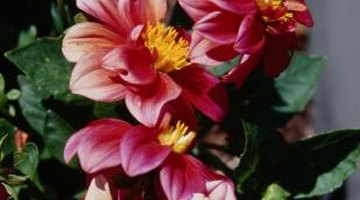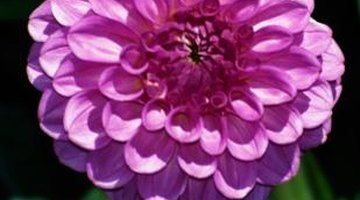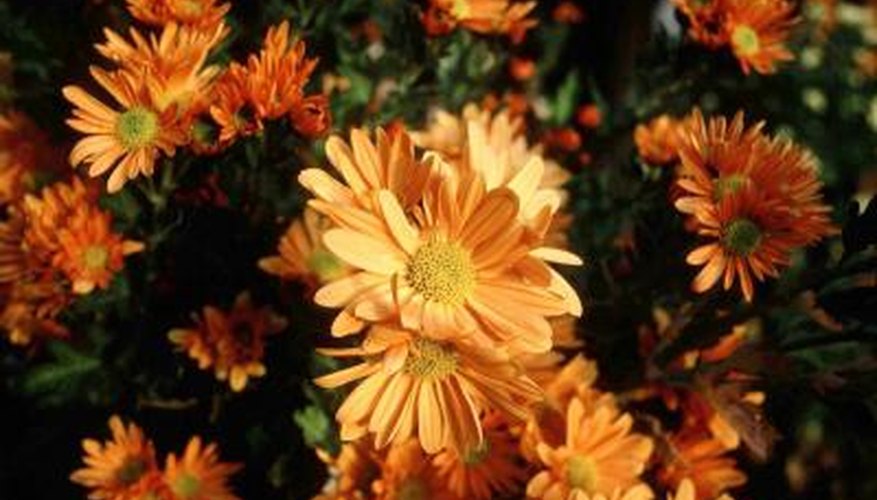There is no flower quite as impressive as a massive dahlia (Dahlia variabilis). With proper care, a hybrid dahlia may produce immense blooms over 30 cm (12 inches) wide. Chrysanthemum (Chrysanthemum morifolium) flowers may be only half as large, but their dahlia-like flowers cover the plant -- often obscuring the foliage altogether. Given their similarities, a small dahlia and a large chrysanthemum may seem identical, but the plants don't even originate on the same continent.
Flowers

Dahlias and chrysanthemums have similar flowers at first glance. They both have multiple forms, from single, flat-petalled flowers with a visible eye to pompon and anemone forms. Dahlias, however, bloom in midsummer in nearly every deep, eye-catching colour except true blue. The blooms range from 1.2 cm (1/2 inch) wide to over 30 cm (12 inches). In contrast, chrysanthemums bloom when summer days shorten, from early to late autumn. Their flowers are also smaller, staying 5 to 15 cm (2 to 6 inches) wide, and have a slightly narrower range of colour, from reds to warm purples, yellows and even bronze.
- Dahlias and chrysanthemums have similar flowers at first glance.
- Their flowers are also smaller, staying 5 to 15 cm (2 to 6 inches) wide, and have a slightly narrower range of colour, from reds to warm purples, yellows and even bronze.
Form

Smaller dahlia plants may grow just 37.5 cm (15 inches) tall and up to 60 cm (2 feet) wide. These miniature dahlias usually have single flowers. Large-flowered hybrids may grow 1.5 to 1.8 m (5 to 6 feet) tall and spread over 1.2 m (4 feet) wide, but these modern dahlias tilt and fall in the garden unless staked, becoming a mass of pointed, serrated leaves. In contrast, while older chrysanthemums may grow 90 cm (3 feet) tall and are rather spindly unless pinched back, newer hybrids naturally branch to become neat, bushy mounds of scalloped, deep-green foliage.
- Smaller dahlia plants may grow just 37.5 cm (15 inches) tall and up to 60 cm (2 feet) wide.
- Large-flowered hybrids may grow 1.5 to 1.8 m (5 to 6 feet) tall and spread over 1.2 m (4 feet) wide, but these modern dahlias tilt and fall in the garden unless staked, becoming a mass of pointed, serrated leaves.
History

Dahlias are native to the warm, sunny climates of central Mexico. The Aztecs grew the plants for their tuberous roots, and Spanish explorers took tubers back to Europe in the 1500s. Too showy for upper-class gardens, dahlias found themselves in common gardens and slowly gained acceptance. In contrast, chrysanthemums are native to China and have a long, cherished history, even earning a mention in the writings of Confucius. A stylised chrysanthemum is the symbol of Japan's emperors.
- Dahlias are native to the warm, sunny climates of central Mexico.
- In contrast, chrysanthemums are native to China and have a long, cherished history, even earning a mention in the writings of Confucius.
Care
Both dahlias and garden chrysanthemums don't appreciate cold weather. Dahlias produce shallow, tuberous roots that can grow all over the British Isles. They may survive winters of Central Scotland and the Northern Isles, but gardeners in those colder zones must lift and store the roots in the autumn. Chrysanthemums have deeper, non-tuberous roots and usually overwinter fairly well in cold zones. Their hardiness depends on their heritage, and hybrids may have widely differing tolerance for cold. Both plants prefer rich, deep soil with regular moisture, and 6 to 8 hours of sunshine.
- Both dahlias and garden chrysanthemums don't appreciate cold weather.
- Chrysanthemums have deeper, non-tuberous roots and usually overwinter fairly well in cold zones.
